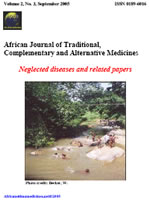
|
African Journal of Traditional, Complementary and Alternative Medicines
African Ethnomedicines Network
ISSN: 0189-6016
Vol. 11, No. 6, 2014, pp. 83-91
|
 Bioline Code: tc14167
Bioline Code: tc14167
Full paper language: English
Document type: Research Article
Document available free of charge
|
|
|
African Journal of Traditional, Complementary and Alternative Medicines, Vol. 11, No. 6, 2014, pp. 83-91
| en |
EVALUATION OF THE EFFECT OF SPATHODEA CAMPANULATA  FLOWER BUD EXUDATE ON CATARACTOGENESIS IN RAT LENSES FLOWER BUD EXUDATE ON CATARACTOGENESIS IN RAT LENSES
Adio, Gbemisola I.; Faluyi, J.O. & Osoniyi, O.
Abstract
Background: The flower bud exudates of Spathodea campanulata is commonly used as a local eye drop in Nigeria and is anecdotally claimed to
improve vision. This study evaluated the anti-cataract activity of Spathodea campanulata (SPCM) flower bud exudates against cataractogenesis using
rat lenses. This was done with a view to providing empirical scientific support for the use of the exudates from SPCM in the treatment and
management of certain eye disorders.
Materials and Methods: Fifty (50) rat lenses were used in this study, i.e. five groups of ten (10) lenses per group. Lenses were incubated in artificial
aqueous humor (Normal control) with simultaneous incubation in 30 mM galactose (Untreated cataract). Co-incubation with captopril (Captopril
treated cataract); 0.1 mg/ml of the exudate (Exudate treated cataract - Low dose) and 0.2 mg/ml of exudate (Exudate treated cataract- High dose)
constituted the study groups. After 72 hr of incubation, lenses were observed for cataract and the preventive potential of the exudate against
cataractogenesis was evaluated through the determination of the levels of anti-oxidant parameters such as total protein (TP), glutathione (GSH),
malondialdehyde (MDA) and activities of superoxide dismutase (SOD) and catalase (CAT) were evaluated in the lens homogenates.
Results: Photographic evaluation of the lenses showed the development of cataract in the untreated cataract group while opacification was retarded in
higher dose exudate-treated and captopril treated lenses. Significant decrease in the levels of GSH and total protein, reduction in SOD and CAT
activities as well as increase in MDA content were observed in cataractous lenses when compared with the normal control. SPCM displayed a doserelated
anti-cataract activity. Captopril showed comparable anti-cataract potential to (0.2 mg/ml) SPCM. GSH, SOD and CAT activity in captopril
treated cataract lenses increased to 75.55%, 64.08% and 72.45% of the normal control values respectively. In (0.2 mg/ml) exudate treated cataract
lenses; GSH, SOD and CAT activity increased to 57.7%, 76.69% and 80.61% respectively.
Conclusion: The study concluded that exudate of SPCM elicited its anti-cataract potential through its anti-oxidant activities.
Keywords
Eye; Cataract; Spathodea campanulata
|
| |
© Copyright 2014 - African Journal of Traditional, Complementary and Alternative Medicines
Alternative site location: http://journals.sfu.ca/africanem/index.php/ajtcam
|
|
